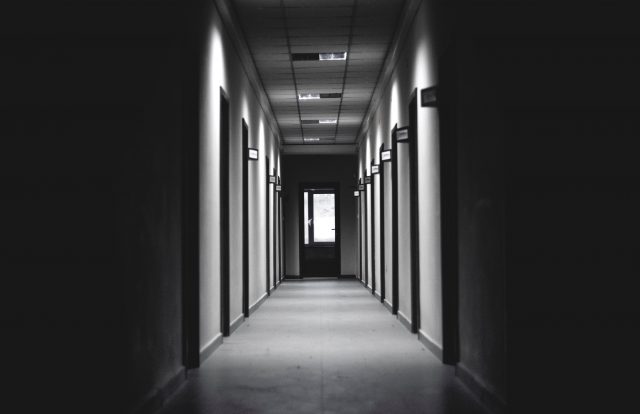From The London Review of Books:
In the original film noir, John Huston’s Maltese Falcon (1941), private investigator Sam Spade (Humphrey Bogart) visits criminal mastermind Kasper Gutman (Sydney Greenstreet) in his San Francisco hotel room to discuss the delivery of a mysterious ornament. The elevator attendant points him in the direction of Room 12c. After some cagey preliminaries, Spade delivers a ferocious ultimatum. Once out in the corridor again, he unlocks a wolfish grin. He’s got Gutman where he wants him. Or so he thinks. As he enters one elevator in order to descend to the lobby, Gutman’s accomplice, Joel Cairo, whom Spade already has grounds to distrust, exits from another. His failure to spot Cairo will very nearly prove fatal. Since Cairo is Peter Lorre at his most flamboyant, you would have to be quite far gone in self-congratulation not to notice him. Spade has failed to understand that a corridor is less a space than a channel of communication through which people, things and messages pass in both directions. Mind the traffic.
Roger Luckhurst’s ambitious and consistently informative cultural history of the corridor makes brief mention of The Maltese Falcon in accounting for film noir’s preoccupation with bleakly anonymous lobbies, passages and hallways. But it’s not the skills and attitudes required to negotiate these spaces that interest Luckhurst. In his view, corridors have a meaning rather than a function. Film noir, he says, set out to ‘interpret’ lobbies, passages and hallways as an index to modern alienation. This is emphatically a cultural rather than an architectural history. Literature, film, TV and other media are called on to elucidate meaning. One touchstone is Stanley Kubrick’s The Shining (1980), in which the camera stalks young Danny at just above ground level as he pedals his tricycle down the interminable featureless passageways of the Overlook Hotel. ‘The Shining,’ Luckhurst concludes, ‘revealed something about the emotional latency of corridors: a simple lesson in the social construction of space.’
The point of a corridor has always been to make it possible to get from one part of a building to another without having to pass through a succession of intervening rooms. Emerging into prominence in 17th-century Italy, corridors found an early champion in John Vanbrugh, whose designs for Blenheim Palace and Castle Howard modelled the new arrangement of a series of rooms opening off a long central axis. The idea gained wide currency during the Enlightenment, Luckhurst notes, as a ‘rational proposal’ for the redistribution of public and private space. Where domestic interiors were concerned, the proposal’s aim was in large measure defensive: a reinforcement of privacy. Luckhurst proves an excellent guide to the distinctly mixed bag of ‘utopian conceptions’ and ‘dystopian results’ that was the outcome of this Enlightenment project.
The first flower of the ‘utopia of corridors’ was the phalanstère (from the Greek phalanx, a body of soldiers in tight formation), dreamed up by the philosopher Charles Fourier and his disciple Victor Considerant as a solution to the social and economic instabilities of post-revolutionary France: a settlement house or estate for 1620 people organised around a street gallery that ran the full length of the second floor. This public thoroughfare was the only way to get from one domestic interior to another, or to gain access to an array of facilities including canteens, nurseries and workshops. Fourier had it in mind to dismantle the bourgeois family. ‘In utopia,’ Luckhurst notes, ‘the corridor always promises radical social reassemblage.’
. . . .
Given his interest in social and political utopia, it’s curious that Luckhurst has nothing at all to say about The West Wing, perhaps the most influential, and certainly the most uplifting, recent exploration of ‘corridors of power’. The show’s signature idea was the walk-and-talk: an elaborately choreographed tracking shot which follows several characters at a time as they navigate the corridors of the White House while engaged in multiple, overlapping conversations.
. . . .
Both draw substantially on a seminal essay by the architectural historian Mark Jarzombek which demonstrates, from the 17th century onwards, the way the corridor became the ‘organising structure’ of the modern large-scale edifice, public or private. Jarzombek points out that in 14th-century Spain and Italy, the term referred ‘not to a space but to a courier, someone who, as the word’s Latin root suggests, could run fast’. A ‘corridor’ was a messenger, a scout, a carrier of money, a negotiator: a person in a hurry.
. . . .
The Gothic persisted, and Luckhurst wrings plenty of ‘spatial dread’ from the corridor of Thornfield Hall in Charlotte Brontë’s Jane Eyre (1847), where Bertha Mason is held captive behind a small black door. More frightening, I’d say, because a lot cannier, is the one on the upper floor of a village inn in Mary E. Braddon’s Lady Audley’s Secret (1862). The scheming protagonist ventures along it in search of the room occupied by her husband’s nephew, Robert, who is hot on her (bigamous) trail. ‘She stopped and looked at the number on the door. The key was in the lock, and her hand dropped upon it as if unconsciously.’ She stands for a few moments trembling, ‘then a horrible expression came over her face, and she turned the key in the lock; she turned it twice, double locking the door.’ No prizes for guessing that she’s about to set fire to the place. The number on the door of Robert’s room has targeted him as unerringly as the GPS lock that launches a drone strike.
Link to the rest at The London Review of Books

Public Domain Dedication